7th Panzer Division (Wehrmacht)
| German 7th Panzer Division | |
|---|---|
|
Unit insignia | |
| Active | 18 October 1939 – 8 May 1945 |
| Country |
|
| Allegiance |
|
| Branch | Heer |
| Type | Panzer |
| Role | Armoured warfare |
| Size | Division |
| Nickname(s) | "Gespensterdivision" |
| Engagements | World War II |
| Commanders | |
| Notable commanders |
Georg Stumme Erwin Rommel Hans Freiherr von Funck Hasso von Manteuffel |
| Insignia | |
| 1940 |
|
| 1941–1945 |
 |
| at Kursk |
 |
The 7th Panzer Division was an armored formation of the German Army in the Second World War. It participated in the Battle of France, the invasion of the Soviet Union, the occupation of Vichy France, and on the Eastern Front until the end of the war.
The division fought successfully in France in 1940, and then again in the Soviet Union in 1941. In May 1942, the division was withdrawn from the Soviet Union and sent back to France to replace losses and refit. It returned to southern Russia following the defeat at Stalingrad, and helped to check a general collapse of the front in a series of defensive battles as part of Army Group Don, and participated in General Erich von Manstein's counterattack at Kharkov.[1] The division fought in the unsuccessful offensive at Kursk in the summer of 1943, suffering heavy losses in men and equipment and was further degraded in the subsequent Soviet counteroffensive.[N 1]
Through 1944 and 1945, the division was markedly understrength and continuously engaged in a series of defensive battles across the eastern front. It was twice evacuated by sea, leaving what was left of its heavy equipment behind each time. After fighting defensively across Prussia and northern Germany, the surviving men escaped into the forest and surrendered to the British army northwest of Berlin in May 1945.
Formation
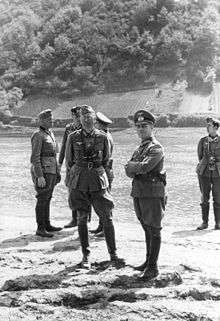
Following the completion of the invasion of Poland, the limited effectiveness of the light divisions caused the German High Command to order the reorganization of the four light divisions into full panzer divisions. In October 1939, the 2nd Light Division became the 7th Panzer Division, one of Germany's only ten armoured divisions. It consisted of 218 tanks in three battalions, with two rifle regiments, a motorcycle battalion, an engineer battalion, and an anti-tank battalion.[3]
Newly promoted General Erwin Rommel, who had served on Hitler's staff during the Invasion of Poland, was able, with an intervention from Hitler, to obtain the command of the division.[4] Upon taking command on 10 February 1940, Rommel quickly set his unit to practicing the maneuvers they would need in the upcoming campaign.[5][6]
Operational history
Invasion of France and Belgium
The invasion began on 10 May 1940. By the third day the 7th Panzer Division under Rommel's command, along with three panzer divisions commanded by General Heinz Guderian, had reached the River Meuse, where they found the bridges had already been destroyed.[7] Rommel was active in the forward areas, directing the efforts to make a crossing, which were initially unsuccessful due to suppressive fire by the French on the other side of the river. By 16 May the division had reached his assigned objective at Avesnes, where the original plan called for him to stop and await further orders. But Rommel pressed on.[8]
On 20 May the division reached Arras.[9] General Hermann Hoth received orders that the town should be bypassed and its British garrison thus isolated. He ordered the 5th Panzer Division to move to the west and 7th Panzer Division to the east, flanked by the SS Division Totenkopf.[10] The following day the British launched a counterattack, deploying two infantry battalions supported by heavily armoured Matilda Mk I and Matilda II tanks in the Battle of Arras. The German 37 mm anti-tank gun proved ineffective against the heavily-armoured Matildas. The 25th Panzer Regiment and a battery of 88 mm (3.5 in) anti-aircraft guns were called in to support, and the British withdrew.[11]
On 24 May, Hitler issued a halt order. The reason for this decision is still a matter of debate. He may have overestimated the size of the British forces in the area, or he may have wished to reserve the bulk of the armour for the drive on Paris.[12][13] The halt order was lifted on 26 May.[13] 7th Panzer continued its advance, reaching Lille on 27 May. For the assault, Hoth placed the 5th Panzer Division under Rommel's command. The Siege of Lille continued until 31 May, when the French garrison of 40,000 men surrendered. By this time the evacuation of the BEF was complete; over 338,000 Allied troops had been evacuated across the Channel, though they had to leave behind all their heavy equipment and vehicles.[14]
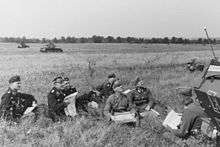
The division, resuming his advance on 5 June, drove for the River Seine to secure the bridges near Rouen. Advancing 100 kilometres (62 mi) in two days, the division reached Rouen to find the bridges destroyed.[15] On 17 June, 7th Panzer was ordered to advance on Cherbourg, where additional British evacuations were underway. The division advanced 240 kilometres (150 mi) in 24 hours, and after two days of shelling, the French garrison surrendered on 19 June.[16] The speed and surprise it was consistently able to achieve, to the point where both the enemy and the Oberkommando des Heeres (OKH; German High Command) at times lost track of its whereabouts, earned the 7th Panzers the nickname Gespensterdivision (Ghost Division).[17]
After the armistice with the French was signed on 22 June, the division was placed in reserve, being sent first to the Somme and then to Bordeaux to re-equip and prepare for Unternehmen Seelöwe (Operation Sea Lion), the planned invasion of Britain.[18] This invasion was later cancelled as Germany was not able to acquire the air superiority deemed a necessity for a successful outcome.[19] In February, the division was placed in reserve and returned to Germany, with General Hans von Funck assuming command. The unit was stationed near Bonn while preparations were being made for an invasion of the Soviet Union. For reasons of deception and security, it remained in Bonn up until 8 June 1941, when the division was loaded onto 64 trains and transported by rail to the eastern frontier. The Division assembled in East Prussia southeast of Lötzen in preparation for Operation Barbarosa, the invasion of the Soviet Union.[20]
Eastern Front

Operation Barbarossa began in the early morning hours of 22 June, at 0305. Resistance at the border was weaker than expected and brushed aside, the tanks of the Division raced forward, covering the 60 km to reach the Neman River at Olita (Alytus) by midday.[N 2] The Soviet 5th Tank Division stationed on the east bank of river at Alytus was completely taken by surprise, and the Germans were able to capture two bridges and establish bridgeheads across the river. Shortly thereafter the Soviets initiated a series of fierce counter-attacks, bringing the German advance to an abrupt halt.[22]
The Soviet unit was well equipped with 300 tanks, of which 55 were of the new T-34 and KV-1 types.[23] Firing from hull down positions on the reverse slopes of hillsides, they caused the panzer forces their first combat losses. Reinforced in the afternoon by tanks from 20th Panzer Division's 21st panzer regiment, General von Funck could fend off probing attacks from the Red Army tanks and pressure the east bank, but decided to delay further advance until his supplies caught up with him.[24]
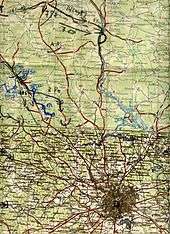
Having lost 80 of its tanks in its probing attacks against the bridgeheads, the 5th Tank division withdrew in the night to the north-east.[25] The path now clear, the 7th Panzer Division advanced another 100 km to the outskirts of Vilnius. Its motorcycle battalion captured the city the following day.[24] Consolidating its position in and around Vilnius, the Division then handed responsibility for the city over to the 20th Motorized Division and resumed its advance east. Unlike previous campaigns, when the Red Army positions were outflanked and cut off the Soviet defenders frequently continued to fight rather than surrender, even though their situation was hopeless. The stubbornness of the Soviet defenders cost greater time and casualties, frustrating the German command. Though creating pockets of resistance, the Soviet command was unable to mount a linear defense, and the vital road and rail communications north east of Minsk were cut on 26 June, only four days into operation Barbarossa. The following day, the division linked up with 18th Panzer division from Panzer Group 2, trapping the bulk of three Soviet Armies, the 3rd, 10th and 13th, in a vast pocket west of Minsk.[26]
In a three-day dash, the division reached the town of Yartsevo, outflanking Soviet positions around Smolensk and threatening the Soviet 20th Army with encirclement. Meanwhile, the 29th Motorized division had captured the city of Smolensk from the south, but with substantial elements tied down at Yelnya, 2nd Panzer Group lacked the strength to link up again with 7th Panzer positions.[27] The gap between the two groups remained open, and the Soviet command was able to move forces both ways through the corridor. On 26 July, together with 20th Motorized division, the 7th Panzer division lunged southwards another 20 kilometers[27] but still could not entirely close the encirclement. In another week, however, pressure from all sides had squeezed the pocket out of existence and the division was finally relieved by infantry units, and taken out of line for refitting and rest.[27]
The 7th Panzer Division started the campaign with 400 officers and 14,000 men.[28] By January 1942, six months from the start of the offensive, the division had suffered 2,055 killed, 5,737 wounded, with 313 missing and another 1,089 sick with frostbite and louse bound diseases. Total casualties were 9,203. In late winter the division took up positions along a defensive line running Yukhnov-Gzhatsk-Zubtsov. On 15 March, it took part in fighting against a series of Soviet offensives as part of the Battles of Rzhev. By 4 April the division was moved to Vyazma. By May 1942, the division was at a strength of 8,589 men and officers, most of whom had not been with the unit at the start of the campaign. As a result, the division was withdrawn to rest and refit in southern France.[28]
France
In mid-May the division was transported by rail to southern France, where it was assigned to coastal protection duties with the 1st Army under the command of General Hans von Funck. Even though the division was to be ready for 1 September, the II/Panzer Regiment 25 was temporarily equipped with French tanks.[29] However, new equipment was issued, including 35 Pz III(J)s, 14 Pz III(N)s and 30 Pz IV(G)s, and the division's two Rifle Regiments were re-designated Panzer-grenadier regiments.[28]
Hitler had been concerned of an Allied invasion of the continent. Following the 8 November Allied landings in West and North Africa, his anxiety rose greatly. On 11 November, the division, as part of Case Anton, was sent to previously Vichy France, to reach the Mediterranean coast between Perpignan and Narbonne. Assembling in a staging area around Aix-en-Provence, the Division prepared for Operation Lila, the seizure of the large French fleet at the naval port of Toulon, to prevent them falling into Allied hands.
For the mission the division was augmented with units from other divisions, including two armoured groups and a motorcycle battalion from the SS Division Das Reich and a marine detachment called Gumprich after its commander. Marine Detachment Gumprich was assigned the mission of seizing the French ships before they could sail or be scuttled.[30] The combat groups entered Toulon at 04:00 on 27 November 1942 and captured the main arsenal and the coastal defences. However, they were unable to prevent the scuttling of the French fleet in Toulon, and the operation ended in failure.
Afterwards, the Division was stationed in a region between Marseille and Avignon. It remained there until January 1943, when the deterioration of the German front in southern Soviet Union necessitated its return to the Eastern Front.[31]
Eastern Front
On transfer to Army Group South, the division fought to stem the Soviet effort to cut off the 1st Panzer Army in the Caucasus. The division checked the Soviet advance on Rostov, maintaining an avenue of escape for the 1st Panzer Army. It continued in actions along the Don and Donetz river lines, and in the Third Battle of Kharkov. In the summer of 1943, the division took part in the offensive at Kursk, serving as part of the armoured formations of Army Detachment Kempf as they attempted to screen the eastern flank of the southern German pincer. The division suffered heavy casualties in this battle, and by the end of the battle 7th Panzer was down to 15 tanks and had an infantry combat strength equivalent to three battalions.[31]
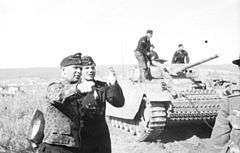
Following the end of the German offensive at Kursk, the division was transferred to the XLVIII Panzer Corps. On 20 August 1943, Generalmajor Hasso von Manteuffel took command of the division. The Soviet Steppe front launched a massive attack spearheaded by two tank armies on 3 August 1943.[N 3]
The German front west of Belgorod was pierced and forced back. The 7th Panzer division, attached to the 4th Panzer Army, gradually gave way battling against the Soviet 40th Army. The division was relieved at the front, enabling it to form a shock group with the Großdeutschland division, which would drive into the Soviet flank and join with reinforcements arriving in the Kharkov region, and blunt the Soviet advance. The counterstroke was led by Großdeutschland, with the 7th Panzer, operating with its 23 remaining operational tanks, covering the left flank. By nightfall, the attackers had driven 24 kilometers into the Red Army flank[N 3] and isolated the forward elements of the Soviet offensive. Success was short lived, however, as further Soviet reinforcements advancing behind the lead elements confronted the German counterattack and reduced the combat effectiveness of the Wehrmacht formations. With this Army Group South withdrew to the line of the Dnieper.[N 3]
Personnel Loses in August for the 7th Panzer division were even higher than in July. The replacement battalion was disbanded as all capable leaders were needed at the front. Losses in heavy infantry weapons and motor vehicles reduced the division's combat value. Remaining operational tanks were amalgamated into a single company.[33] The battered division withdrew to the Dnepr position, crossing the river at Kremenchug.
The Division then fought in the defensive Battle of Kiev and the German counterattack at Zhitomir. During these battles the division was twice cited for distinguished conduct.[31] After this the Division fought in a series of heavy defensive battles during the long retreat across the Ukraine.
Courland Pocket
In July 1944, the division was transferred north to the Baltic states and the northern area of Army Group Center in response to the Soviet Baltic Offensive. The division participated in defensive fighting in Lithuania. Late in the summer the 1st Baltic Front attempted to reach the Baltic sea through the Third Panzer Army. On 21 September, the division moved more than 100 km north to an area east of Memel where there was heavy fighting. The German forces were forced to fall back during the follow-up Memel Offensive, to a defensive perimeter around the coastal town of Memel. With the Memel bridgehead isolated, the Division was relieved by an infantry division and was loaded onto ships and transported by sea out of the pocket, leaving its heavy equipment behind with the German forces still holding. On 7 November 1944, the remainder of the division was gathered at the training area Aryes in East Prussia and the division was partially reorganized. Here it formed a reserve for the 2nd Army of Army Group Center.
Germany
In January, the Soviet 2nd Belorussian Front mounted a massive attack and broke through the defenses of the 2nd Army, which was forced back north and west. The kampfgruppe of the 7th Panzer fought a rearguard action through north Poland at Elbing and to the east of Graudenz. The Division crossed the Vistula and then continued in defensive battles for and around Konitz. In mid-February 1945, the Division was pushed back into northern Pomerania. In March 1945 the division was fighting a delaying action at Gdynia, north and west of Danzig. On 19 April 1945, the surviving men were again taken off by sea, evacuating from the Hel Peninsula. Only a small remnant of the Division came back from the Hel Peninsula. This remnant assembled at the Baltic Sea island of Usedom in western Pomerania and retreated west through Prussia until finally surrendering to the British Army at Schwerin north and west of Berlin in May 1945.
Allegations of war crimes
During the fighting in France, the division, alongside troops from 5th Panzer division, committed numerous atrocities against colonial French troops including the mass murder of 50 surrendering Non-commissioned officers and men at Quesnoy and Airaines. According to historian Martin Alexander, "Indeed, the soldiers of the 'Ghost Division' and its partner in crime, 5th Panzer Division, committed numerous atrocities against French colonial troops in 1940, murdering fifty surrendered non-commissioned officers and men at Airaines"[34]
According to the military historian David Stone, "On 7 June, a number of soldiers of 53eme Regiment d'Infanterie Coloniale were shot, probably by troops of the 5th Panzer Division, following their surrender after a spirited defense in the area of Airaines, near Le Quesnoy. Similar acts had also been perpetrated by soldiers of Rommel's 7th Panzer Division on 5 June against the defenders of Le Quesnoy. Rommel noted in his own account that "any enemy troops were either wiped out or forced to withdraw"; at the same time he also provided the disparaging (but possibly somewhat contradictory in light of his first note) observation that "many of the prisoners taken were hopelessly drunk."[35] The division is also considered by Raffael Scheck to be responsible for the execution of POW's in Hangest-sur-Somme, In Hangest-sur-Somme, some captured Tirailleurs and a French second lieutenant were shot by Germans in black uniforms, most likely members of Rommel's 7th Panzer Division.[36]
Commanding officers
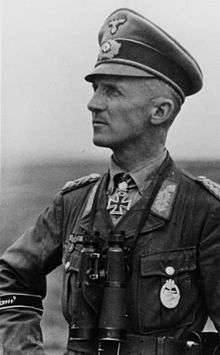
- Generalmajor Georg Stumme (18 October 1939 – 5 February 1940)
- Generalmajor Erwin Rommel (5 February 1940 – 14 February 1941)
- Generalmajor Hans Freiherr von Funck (15 February 1941 – 17 August 1943)
- Oberst Wolfgang Gläsemer (17 August 1943 – 20 August 1943)
- Generalmajor Hasso von Manteuffel (20 August 1943 – 1 January 1944)
- Generalmajor Adelbert Schulz (1 January 1944 – 28 January 1944)
- Oberst Wolfgang Gläsemer (28 January 1944 – 30 January 1944)
- Generalmajor Dr. Karl Mauss (30 January 1944 – 2 May 1944)
- Generalmajor Gerhard Schmidhuber (2 May 1944 – 9 September 1944)
- Generalmajor Dr. Karl Mauss (9 September 1944 – 31 October 1944)
- Generalmajor Hellmuth Mäder (31 October 1944 – 30 November 1944)
- Generalmajor Dr. Karl Mauss (30 November 1944 – 5 January 1945)
- Generalmajor Max Lemke (5 January 1945 – 23 January 1945)
- Generalmajor Dr. Karl Mauss (23 January 1945 – 25 March 1945)
- Oberst Hans Christern (26 March 1945 – 8 May 1945)
Organization / Order of Battle
May 1940
- 25th Panzer Regiment, under command of Colonel Karl Rothenburg
- 66th Panzer Battalion, under command of Major Rudolf Sieckenius
- 6th Motorized Rifle Regiment, under command of Colonel Erich von Unger
- 7th Motorized Rifle Regiment, under command of Colonel Georg von Bismarck
- 37th Reconnaissance Battalion, under command of Major Erdmann (KIA 28 May)
- 7th Motorcycle Battalion, under command of Major Friedrich-Carl von Steinkeller
- 78th Motorized Artillery Regiment, under command of Colonel Frölich
- 42nd Antitank Battalion, under command of Lieutenant Colonel Johann Mickl
- 58th Combat Engineer Battalion, Motorized, under command of Major Binkau (KIA 13 May)
- 59th Light Anti-aircraft Detachment, under command of Major Schrader
Equipment
The divisional artillery consisted at this time of 24 towed 105 mm LeFH (Light field howitzers). The divisional Anti-tank battalion and the Infantry Anti tank platoons all contained towed 37mm PAK 36. The infantry all traveled by truck or by motorcycle.[37] Both Panzer Regiment 25, and Panzer battalion 66 had gone into action in Poland with only Pz I and Pz II light tanks. On assignment to 7th Panzer division, these units were to adopt the Czech 38t in their organization as the main battle tank in their light companies, along with the Pz IV in the medium companies.[38] However, this process was not complete by the start of the battle with France and the division went into action in May 1940 with 225 tanks (34 Pz I, 68 Pz II, 91 Pz 38t, 24 Pz IV and 8 command variants).[39][40]
July 1941
_Ausf._S.jpg)
- 25 Panzer Regiment (I, II & III Battalions)
- 7th Infantry Brigade
- 6 Motorized Rifle Regiment (I & II Battalions)
- 7 Motorized Rifle Regiment (I & II Battalions)
- 7 Motorcycle Battalion
- 37 Reconnaissance Battalion
- 78 Motorized Artillery Regiment (I, II & III Battalions)
- 58 Motorized Combat Engineer Battalion
- 42 Antitank Battalion
- 58 Field replacement battalion
- Divisional services
The 25th Panzer Regiment had absorbed the 66th Panzer Battalion, which had been the panzer force of the original 2nd Light Division. By 1941, this unit had become the 3rd Battalion of the 25th Panzer Regiment. On the eve of operation Barbarossa, the tank strength of the division had risen to 53 Pz II, 167 Pz 38t, 30 Pz IV & 15 French Char B, for a total of 265 tanks. The artillery regiment had added a 3rd battalion of heavy guns, with 2 batteries of 150 mm sFH, and 1 battery of 100 mm guns.
Each panzer battalion comprised 4 companies instead of 3, and a 3rd company had been added to the antitank battalion. A field replacement battalion of 3 companies had also been added.[42] The division totaled 400 officers leading 14,000 men at the start of Barbarossa.[43]
June 1943
In May 1942, the division was withdrawn from the Soviet Union and rebuilt and reorganized in France. The Panzer Regiment now consisted of 2 battalions equipped with German tanks. The infantry regiments were now renamed Panzer Grenadiers, with II / Panzer Grenadier Regiment 6 equipped with armored half trucks. The motorcycle battalion was merged into the reconnaissance Battalion and contained an armored car company, a half track company, 2 motorcycle companies and a heavy company.
On its return to Russia in December 1942, the Panzer Regiment was now equipped with 21 Pz II, 91 Pz III (50mm long), 14 Pz III (75mm), 2 Pz IV (75mm), 18 Pz IV (75mm long), 9 Befehl (command), a total of 155 tanks.[44]
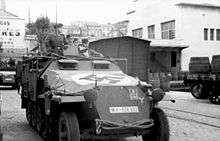
- 25 Panzer Regiment
- 6 Panzer Grenadier Regiment
- 7 Panzer Grenadier Regiment
- 7 Reconnaissance Battalion
- 78 Motorized Artillery Regiment
- 58 Armoured Combat Engineer Battalion
- 42 Antitank Battalion
- 296 Anti-aircraft Battalion (attached Army troops)
- 58 Field replacement battalion
- Divisional services
Notes
References
Citations
- ↑ Glantz 1991, chptr 4, Operation Star.
- ↑ Nevenkin 2008, p. 233.
- ↑ Fraser 1993, pp. 156–157.
- ↑ Butler 2015, p. 151.
- ↑ Fraser 1993, pp. 151, 161.
- ↑ Mitcham 2001, p. 80.
- ↑ Butler 2015, pp. 154–155.
- ↑ Butler 2015, pp. 160–161.
- ↑ Butler 2015, p. 164.
- ↑ Fraser 1993, p. 183.
- ↑ Butler 2015, pp. 165–166.
- ↑ Butler 2015, p. 166.
- 1 2 Hoffmann 2004, p. 24.
- ↑ Butler 2015, pp. 169–171.
- ↑ Butler 2015, pp. 172, 174.
- ↑ Fraser 1993, pp. 204–206.
- ↑ Fraser 1993, pp. 191–192.
- ↑ Butler 2015, p. 177.
- ↑ Hoffmann 2004, p. 26.
- ↑ Stolfi 1991, p. 46.
- ↑ Glantz 1991, p. 173.
- ↑ Robert Kershaw, War Without Garlands: Operation Barbarossa 1941-1942 (Kindle Location 2054).
- ↑ Glantz 1991, p. 35.
- 1 2 Stolfi, Russell, A bias for action, 52
- ↑ Manteuffel, Die 7. Panzer–Division im ZweitenWeltkrieg, p135–6.
- ↑ Glantz 1991, p. 179.
- 1 2 3 Glantz 1993, pp. 389–392.
- 1 2 3 Mitcham 2001, p. 81.
- ↑ Jentz 1996, p. 219.
- ↑ Deist & Maier 1990, p. 827.
- 1 2 3 Mitcham 2001, p. 82.
- ↑ Glantz 1991, pp. 350–360.
- ↑ Nevenkin 2008, p. 216.
- ↑ Alexander 2012, p. 332.
- ↑ Stone 2009, p. 109.
- ↑ Scheck 2006, p. 26.
- ↑ Nafziger 1999, pp. 64-69.
- ↑ Jentz 1996, p. 106.
- ↑ Jentz 1996, p. 120.
- ↑ Niehorster, Leo (8 November 2008). "German Army Fielded Tank Strengths, 10.05.1940". World War II Armed Forces - Orders of Battle and Organizations. Open Publishing. Retrieved 14 October 2015.
- ↑ http://niehorster.org/011_germany/41_organ_army/41_div_pz-07.html
- ↑ Nafziger 1999, pp. 64-69, 216.
- ↑ Samuel W. Mitcham, Panzer Legions: A Guide to the German Army Tank Divisions of World War II
- ↑ Jentz 1996, p. 32.
Bibliography
- Alexander, Martin (2012). "French Surrender in 1940: Soldiers, Commanders, Civilians". In Afflerbach, Holger; Strachan, Hew. How Fighting Ends: A History of Surrender. Oxford ; New York: Oxford University Press. ISBN 978-0-19-969362-7.
- Butler, Daniel Allen (2015). Field Marshal: The Life and Death of Erwin Rommel. Havertown, PA; Oxford: Casemate. ISBN 978-1-61200-297-2.
- Deist, Wilhelm; Maier, Klaus A.; et al. (1990). Germany and the Second World War. Oxford University Press. ISBN 0-19-822884-8.
- Fraser, David (1993). Knight's Cross: A Life of Field Marshal Erwin Rommel. New York: HarperCollins. ISBN 978-0-06-018222-9.
- Glantz, David M. (1991). From the Don to the Dnepr: Soviet Offensive Operations, December 1942 – August 1943. Routledge. ISBN 978-0-7146-4064-8.
- Glantz, David M. (1993). The initial period of war on the Eastern Front. London; Portland, Origon: F. Cass. ISBN 978-0-7146-3375-6.
- Hoffmann, Karl (2004). Erwin Rommel, 1891-1944. Commanders in Focus. London: Brassey's. ISBN 1-85753-374-7.
- Jentz, Thomas L. (1996). Panzer Truppen: The Complete Guide to the Creation & Combat Employment of Germany's Tank Force 1933–1942. I. Schiffer Publishing. ISBN 978-0-88740-915-8.
- Nafziger, George F. (1999). The German Order of Battle: Panzers and Artillery in World War II. London: Greenhill Books. ISBN 978-1-85367-359-7.
- Nevenkin, Kamen (2008). Fire Brigades: The Panzer Divisions 1943–1945. Winnipeg, Manitoba: J.J. Fedorowicz. ISBN 978-0-921991-92-2.
- Mitcham, Samuel (2001). The Panzer Legions: A Guide to the German Army Tank Divisions of World War II and their Commanders. Westport, Conn.: Greenwood Press. ISBN 978-0-313-31640-1.
- Scheck, Raffael (2006). Hitler's African victims: The German Army massacres of Black French soldiers in 1940. Cambridge [England]; New York, NY: Cambridge University Press. ISBN 978-0-521-85799-4.
- Stolfi, Russell (1991). A bias for action : the German 7th Panzer Division in France & Russia 1940-1941. Quantico, VA: Marine Corps University: Command and Staff College Foundation. OCLC 28260426.
- Stone, David (2009). Hitler's Army: The Men, Machines, and Organization: 1939–1945. Minneapolis, MN: Zenith Press. ISBN 978-0-7603-3750-9.
- War Office German order of battle, 1944 : the regiments, formations and units of the German ground forces London : Arms & Armour Press; New York : Hippocrene Books, (1975).

